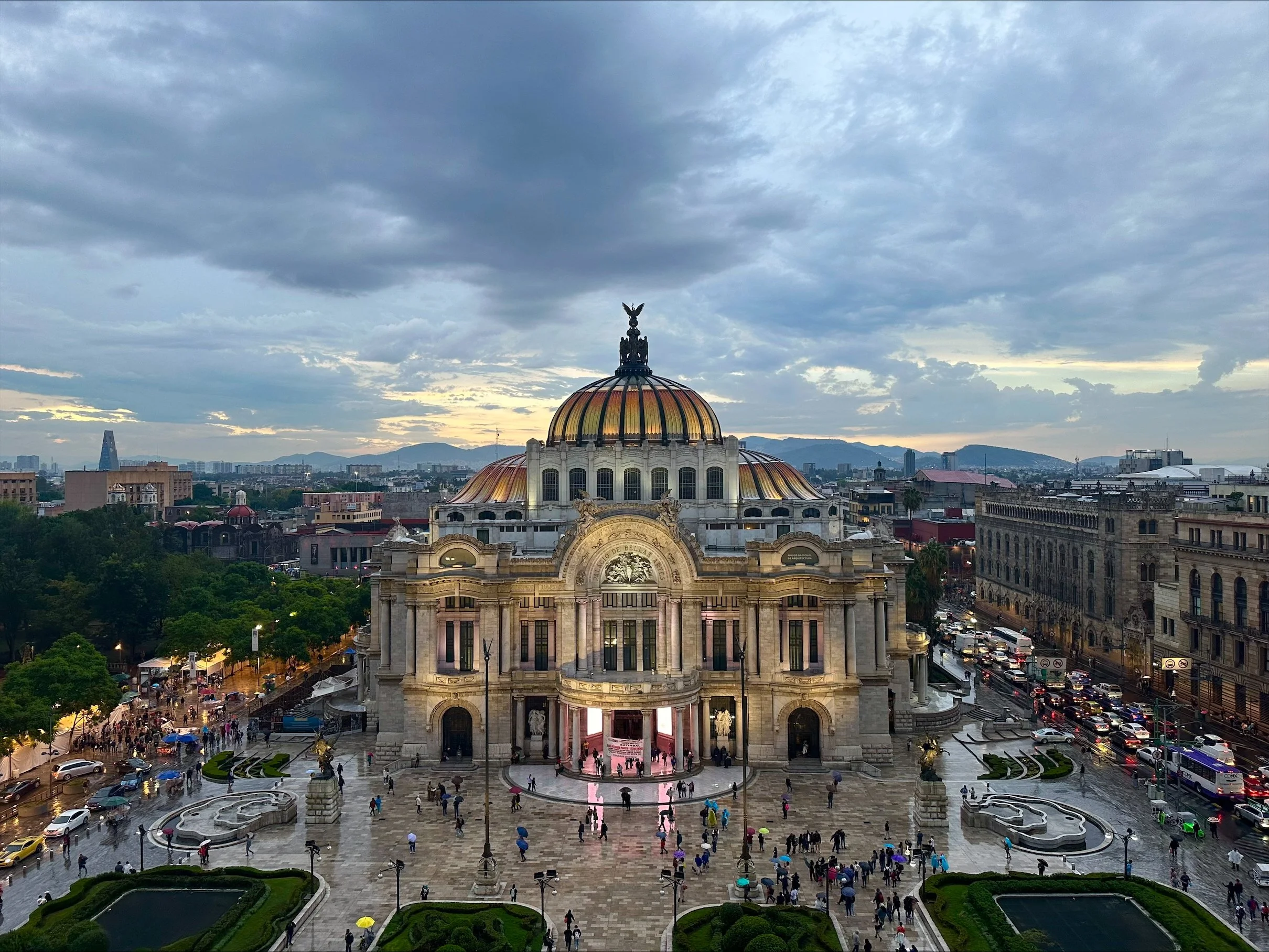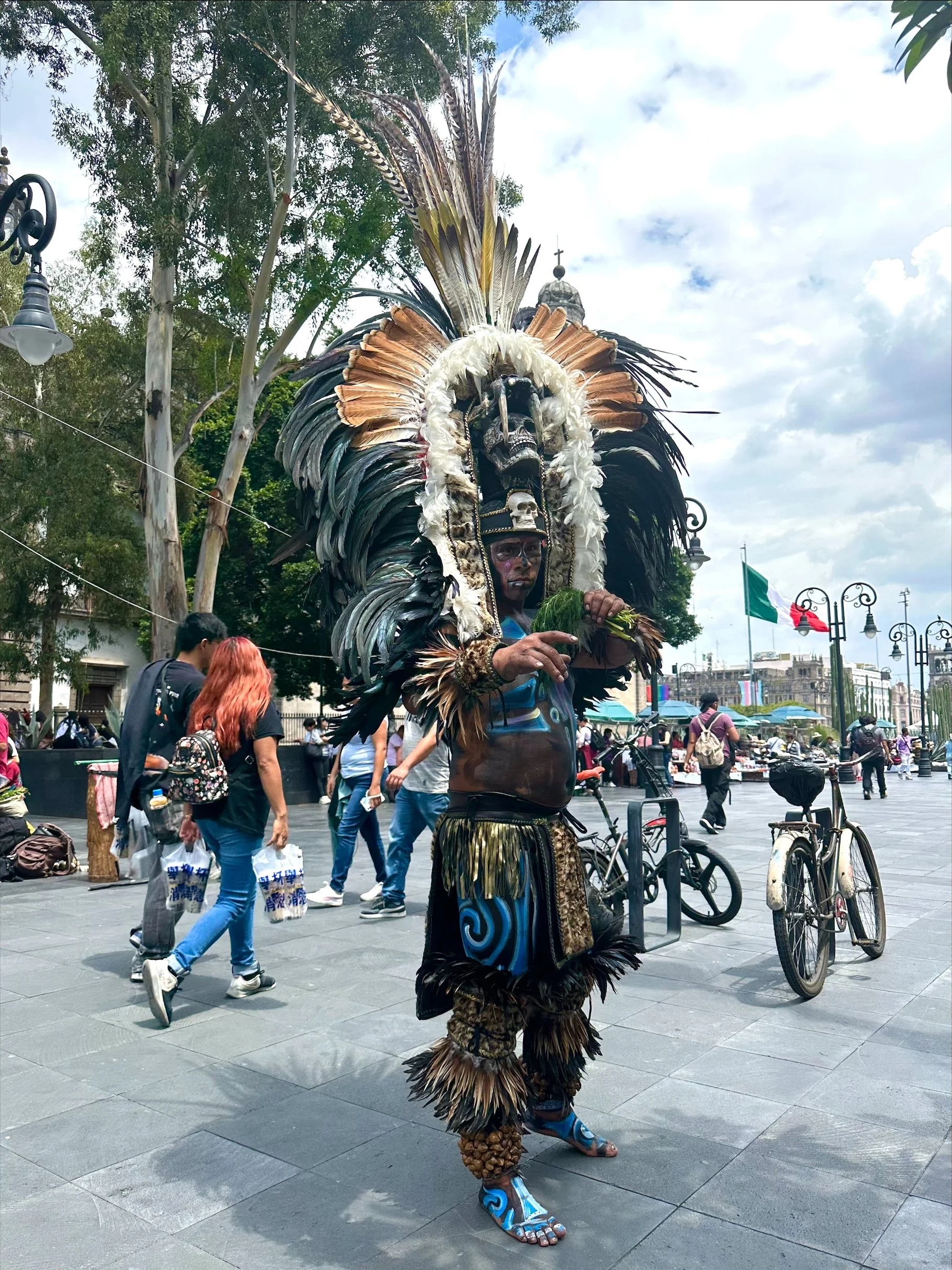Resisting and Reinventing: Identity, Media, and U.S.-Mexico Relations
The UNC Journal of Foreign Affairs blog has the pleasure of publishing this longer-form guest blog post by UNC student Aaliyah Mitchell, who studied at El Colegio de Mexico in Mexico City over summer 2024. The article has been slightly modified from its original format, and was written for a class titled “El Norte/ La Frontera in Ten Essays.” The original bibliography can be found at the bottom of this article.
Photo of Pre-Hispanic dancers chatting after a performance, by Aaliyah Mitchell
In the Borderlands, where cultures fuse and harden into new cultural identities, we feel the spirit of the pachuco—cloaked by defiance and suspended between the pull of Mexican roots and the promise of what it means to be United Statsian. It is equally the emergence of the new mestiza, navigating the labyrinth of duality and forging her existence from the collision of two plains. The Mexican identity is alive! It is forged by the fires of revolution, shaped by the waves of reformation, tested by the trials of migration, and vividly alive through every unique exchange at the U.S.-Mexico Border.
As Mexican identity evolves, media plays an undeniable role in shaping public opinions by influencing how identity, migration, and crime are perceived. This piece combines two perspectives: the cultural dynamics of identity, as explored through the works of Octavio Paz, Gloria Anzaldúa, and Carlos Monsiváis, and the role of media in shaping narratives of migration and crime in Mexico, drawing insights from Ana Arjona, Enrique Desmond Arias, Rodrigo Peña, Sandra Ley, and Sergio Aguayo. These perspectives reveal how identity and narratives are forged, negotiated, and represented within the context of U.S.-Mexico interactions.
The Cultural Dynamics of Identity
Identity, at its core, is deeply personal; yet, relies on external perception. It is the blend of values, language, tradition, and experiences that shape how people and communities view themselves and how they are viewed by those around them. Language, as a fundamental aspect of cultural expression, plays a pivotal role in this dynamic; it serves not only as a mode of communication but as a reflection of heritage and identity. The phenomenon of Spanglish, a hybrid dialect and arguably its own future language, exemplifies how language can evolve in response to cultural, geographical, and/or social pressures. Spanglish represents a unique linguistic adaptation that blends languages to navigate the complexity of a diverse cultural landscape.
The pachuco represents cultural orphanhood, the internal conflict between maintaining cultural heritage and integrating into American society. Pachucos, characterized by their distinctive behavior and unique dialect known as Caló, represent the struggle to maintain identity with unrelenting pressures of Americanization. Octavio Paz’s The Labyrinth of Solitude highlights this tension, noting that the pachuco has “lost his whole inheritance: language, religion, customs, beliefs,” leaving only a body and soul to confront societal elements (Paz 17). Similarly, figures like Tin Tan transformed the pachucos image into one of cultural negotiation, bridging the gap between Mexican and American identities. As Carlos Monsiváis writes, Tin Tan’s humor and charm redefined the pachucos as an endearing character rather than a threatening figure of urban legend. This transformation from a symbol of defiance to one of cultural negotiation highlights how the pachuco has evolved to represent the nuances of cultural hybridity.
Photo of the Palacio de Bellas Artes in Mexico City, by Aaliyah Mitchell
Gloria Anzaldúa’s concept of the new mestiza in Borderlands/La Frontera: The New Mestiza describes individuals living at the intersection of multiple worlds—a sort of nepantla or in-betweenness that transcends geographical boundaries. Anzaldúa employs the metaphor of a turtle, carrying “home” on its back, to illustrate how cultural identity serves as both a source of strength and struggle (Anzaldúa 21). This metaphor resonates with modern Latinx communities advocating for bilingual education and cultural representation. These initiatives aim to honor cultural roots while preparing individuals to navigate a multicultural landscape, emphasizing the dual role of cultural preservation and integration. In this way, the United States is both the melting pot and the salad bowl—melting cultures into a cohesive mass while preserving distinct cultural elements.
An additional layer of identity is seen in language’s adaptability across generations. For instance, Latinx youth often embrace Spanglish as a bridge between their heritage and the predominantly English-speaking society they inhabit. Some Spanish-speakers in the United States claim Spanish as their mother tongue, despite some having been born or raised in an English-speaking society. This linguistic flexibility highlights the ongoing negotiation of identity. Scholars have noted that this phenomenon fosters a hybrid cultural framework where both languages influence one another. Such adaptations ensure that cultural heritage is not lost but rather transformed to reflect contemporary realities.
Media and the Narrative of Migration
Media portrayal can either humanize migrants or depict them as threats to social and economic stability. People migrate for many reasons: asylum, opportunity, family reunification, etc. Not all migrants are criminals, and not all migrants come with good intentions, but generalizing a group of people based on the actions of a few is unfair and overlooks the diverse motivations and contributions of each individual. The variation in coverage during the 2019-2020 migrant “crisis” illustrates this dynamic: some outlets highlighted the humanity of migrants, showing families in distress and children crying at the border, while others dehumanized them, framing them as criminals and robbers of “American jobs.” Similarly, language choices in headlines, such as “crisis” or “invasion,” frame the discourse in ways that influence public opinion and policy outcomes. This dichotomy influenced policies, such as the U.S. Migrant Protection Protocols, which required asylum seekers to remain in Mexico while their claims were processed. These policies placed immense pressure on the Mexican government to manage large migrant populations.
The media also shapes perceptions of crime, particularly organized crime and its connection to migration. Enrique Desmond Arias’s Criminal Enterprises and Governance in Latin America and the Caribbean explores how sensationalist reporting focuses on dramatic arrests and violence, diluting the complexity of criminal activity and its socioeconomic roots. Falko Ernst’s studies further show how such portrayals lead to ineffective policies, such as increased militarization, which fails to address underlying issues like poverty and marginalization. By focusing on spectacle rather than substance, media narratives can distort systemic problems and hinder meaningful solutions. Moreover, media coverage often overlooks the resilience of migrant communities. Stories that highlight migrant-led initiatives, like festivals, conferences, and rallies, are rare but essential. These narratives challenge stereotypes and generalization to provide a more balanced view of migration. In that same vein, highlighting immigrant-owned businesses that bring flavor and artistry to their communities could foster greater empathy and understanding, counteracting divisive ideals.
Media Coverage During Crises
The COVID-19 pandemic exacerbated vulnerabilities among migrant populations and highlighted the challenges of accurate media representation. Rodrigo Peña’s research on criminal governance during the pandemic reveals how organized crime groups exploited the crisis to strengthen their control. Often through coercion, they provided what the government couldn’t: stability, food, and resources, typically under the condition that these citizens would become involved or indebted to them. Media coverage during this period often sensationalized these developments, overshadowing the systemic issues at play.
Sergio Aguayo’s The Zeta Yoke offers another perspective on how media coverage during times of crisis can shape public discourse and criminal governance. Aguayo explains how journalistic sensationalism can obscure systemic issues, such as the relationships between criminal organizations and political actors. In the defense of journalists, when faced with the daunting task of reporting quickly, accurately, and under constantly changing conditions with limited access to reliable information, it can be extremely difficult to report as accurately and comprehensively as possible. Even so, it was and is absolutely necessary to have more nuanced and comprehensive media coverage that can influence more fitting and effective public and political responses.
While on the topic of the journalistic shortcomings during the pandemic, it is important to have context. Reporting on sensitive topics like migration and crime with accuracy can be difficult for journalists who are reporting on their lived experiences or, adversely, have little-to-no connection with the subject matter. Reporter Nikole Hannah-Jones in a podcast titled The Half Truths About Lynching discusses the idea that objectivity in journalism is a myth, as you cannot write about something you are not aware of nor can you completely remove yourself from what you have experienced. She emphasized that the only way to combat this phenomenon is with rigor. Our view of the world is shaped by our personal, lived experiences, and it takes rigor to broaden that view through research, hard work, and the willingness to be understanding. Additionally, journalists also work under dangerous conditions, facing threats from criminal organizations and government actors. These working conditions can limit the scope and depth of coverage, leading to reporting that lacks context and critical analysis or focuses on irrelevant or inaccurate material. The media has a responsibility to balance the need for compelling stories with the ethical necessity to report accurately and fairly.
The pandemic also highlighted how media can either exacerbate or alleviate social tensions. Reports that focused on the struggles of migrant workers during lockdowns, for instance, brought attention to their essential contributions but often failed to advocate for systemic change. In contrast, investigative journalism that exposed corruption or inefficiencies in government responses provided a crucial accountability mechanism. These examples underscore the dual role of media as both a reflection of societal values and a catalyst for change.
Synthesizing Identity and Media Narratives
Photo of Pre-Hispanic dancer posing, by Aaliyah Mitchell
The interaction between Mexican and American cultures, as well as the media’s role in shaping perceptions of migration and crime, highlights the complexity of identity and governance. Octavio Paz’s exploration of the pachucos and Gloria Anzaldúa’s concept of the new mestiza highlight the fluidity and resilience of cultural identities. With this, the media must strive to reflect this complexity by avoiding sensationalism and generalization. Ultimately, Mexican identity and the perceptions surrounding migration and crime are not static constructs. They are living entities, shaped by cultural exchanges, media representation, and the policies they inform. By understanding these dynamics, we can work toward a more nuanced and equitable approach to identity and governance in the Borderlands and beyond. Simplified and sensationalized media coverage, especially during the COVID-19 pandemic can lead to policies that do not address the truly alarming causes of crime like poverty and marginalization. The integration of cultural insights and media analysis is essential for fostering dialogue and policy that reflect the realities of both migrant and host communities.
Works cited
Anzaldúa, Gloria. Borderlands/La Frontera: The New Mestiza. Aunt Lute Books, 1987, pp. 1–24, 77–91.
Paz, Octavio. The Labyrinth of Solitude. Translated by Lysander Kemp, Groove Press, 1961.
Monsiváis, Carlos. Mexican Postcards. Translated by John Kraniauskas, Verso, 1997, pp. 106–118.
Rascoe, Ayesha. “A New South Florida Dialect Is Forming in Real Time.” NPR, 18 June 2023, www.npr.org/2023/06/18/1182941050/in-south-florida-a-new-dialect-is-forming-in-real-time. Accessed 30 July 2024.
Aguayo, Sergio and Dayán, Jacobo (2017). The Zeta Yoke. Mexico, El Colegio de México.
Arjona, Ana; Kasfir, Nelson; Mampilly, Zachariah (2015). 'Introduction' in Arjona, Ana; Kasfir, Nelson; Mampilly, Zachariah, Rebel Governance in Civil War. New York, Cambridge University Press.
Desmond Arias, Enrique (2017). Criminal Enterprises and Governance in Latin America and the Caribbean, Cambridge, Cambridge University Press.
Ernst, Falko (2015). 'Legitimacy matters: Los Caballeros Templarios and the mutation of the Mexican organized crime', Journal of Money Laundering Control.
Wallace, Lewis Raven. (2019, November 4). The view from somewhere: The Half Truth about lynching on Apple podcasts. Apple Podcasts. https://podcasts.apple.com/us/podcast/the-half-truth-about-lynching/id1481617425?i=1000455962172.



